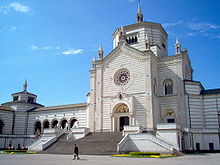- Cimitero Monumentale di Milano
-
The Cimitero Monumentale in Milan, Italy is a very large cemetery, noted for its abundance of highly artistic and often imposing tombs.
It was designed by the architect Carlo Maciachini (1818-1899). It was planned to consolidate a number of small cemeteries that used to be scattered around the city into a single location, at that time well removed from the thickly built central city area.
It opened in 1866 and since then has been filled with a wide range of both contemporary and classical Italian sculptures as well as Greek temples, elaborate obelisks, and other original works such as a scaled-down version of Trajan's Column. Many of the tombs belong to noted industrialist dynasties, sometimes eponymous of world famous businesses and brands.
The main entrance is through the large Famedio, a massive Hall-of-Fame-like Neo-Medieval style building of marble and stone that contains the tombs of some of the city's and the country's most honored citizens.
The Civico Mausoleo Palanti designed by the architect Mario Palanti is a tomb built to house the dead famous "Milanesi" not enough for admission to the memorial chapel, but representative of some merit had in life. The memorial of about 800 Milanese killed in Nazi concentration camps is located in the center instead, just get off the stairs of the memorial chapel, and is the work of the group BBPR, formed by leading exponents of Italian rationalist architecture, one of which (Gianluigi Banfi) died in Mauthausen in 1945. The cemetery has a special section for those who do not belong to the Catholic religion.
The cemetery has a non-Catholic section and a Jewish section.
Near the entrance is an exhibit of prints, photographs, and maps outlining its historical development. The exhibit includes two battery-operated electric hearses built in the 1920s.
Contents
Famous graves
Discreet posters located throughout the cemetery point visitors to several of the most remarkable tombs and monuments. Some of the personages interred here include:
- Alberto Ascari (1918-1955), Formula One champion driver
- Antonio Ascari (1888-1925), Grand Prix champion driver
- Ernesto Bazzaro (1859 - 1937), sculptor
- Luca Beltrami (1854-1933), architect
- Arrigo Boito (1842-1918), composer and librettist
- Gino Bramieri (1928-1996), comedian and actor
- Carlo Cattaneo (1801-1869), philosopher, patriot
- Alfredo Catalani (1854-1893), composer
- Walter Chiari (1924-1991), actor
- Franco Corelli (1921-2003), opera tenor
- Filippo Filippi (1830-1887), journalist, music critic
- Eva Duarte de Perón (1919-1952), trade union and charity leader; secretly buried as María Maggi between 1955 and 1971
- Giorgio Gaber (1939-2003), singer-songwriter, comedian
- Giuseppe Gervasini (1867-1941), religious figure
- Luigi Giussani (1922-2005), priest, founder of "Communion and Liberation"
- Vladimir Horowitz (1903-1989), pianist
- Herbert Kilpin (1870-1916), founder of football club A.C. Milan
- Anna Kuliscioff (1857, 1925), political activist
- Emilio Longoni (1859-1932), painter
- Alessandro Manzoni (1785-1873) poet, novelist, considered the founder of modern Italian language, tomb located at the very center of the Famedio
- Filippo Tommaso Marinetti (1876-1944), poet and main founder of the futurist movement
- Giovanni Pesce (1918-2007), communist partisan
- Francesco Maria Piave (1810-1876), librettist, poet
- Amilcare Ponchielli (1834-1886), composer
- Salvatore Quasimodo (1901-1968), 1959 Nobel prize in literature
- Medardo Rosso (1858-1928), sculptor
- Temistocle Solera (1815-1878), poet, opera composer, librettist
- Arturo Toscanini (1867-1957), conductor and cellist
- Filippo Turati (1857-1932), politician
- Bruno Munari (1907-1998), artist
- Leo Valiani (1909-1999), writer, politician
- Giuseppe Verdi (1813 – 1901), composer, was buried there for about one month before being moved to the Casa di Riposo per Musicisti
In the movies
The Hall of Fame of the Monumentale is prominently featured in a climactic scene of the 2009 film I Am Love.
See also
- Certosa di Bologna, the site of the city’s monumental cemetery
- Monumental Cemetery of Staglieno, in Genoa
- Monumental Cemetery of Bonaria in Sardinia
Coordinates: 45°29′09″N 9°10′45″E / 45.485831°N 9.179056°E
External links
Categories:- Cemeteries in Italy
- Buildings and structures in Milan
- Visitor attractions in Milan
- 1866 establishments in Italy
- Burials at the Cimitero Monumentale di Milano
Wikimedia Foundation. 2010.

